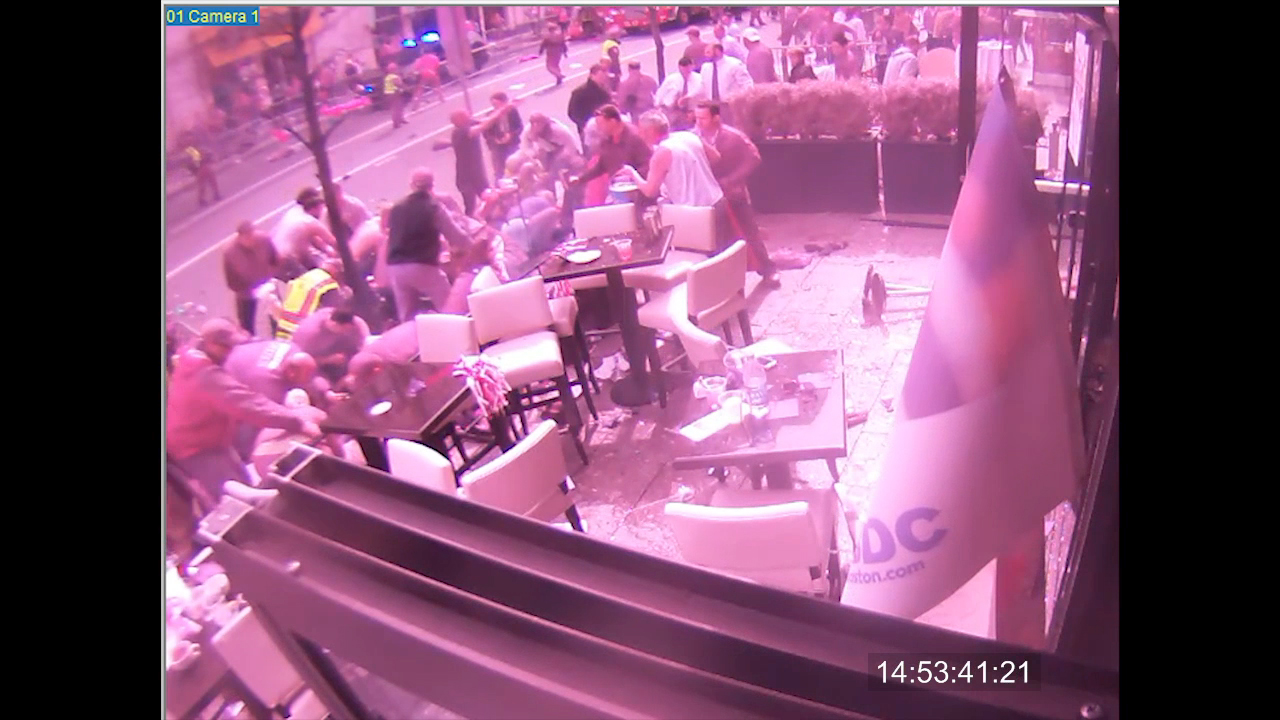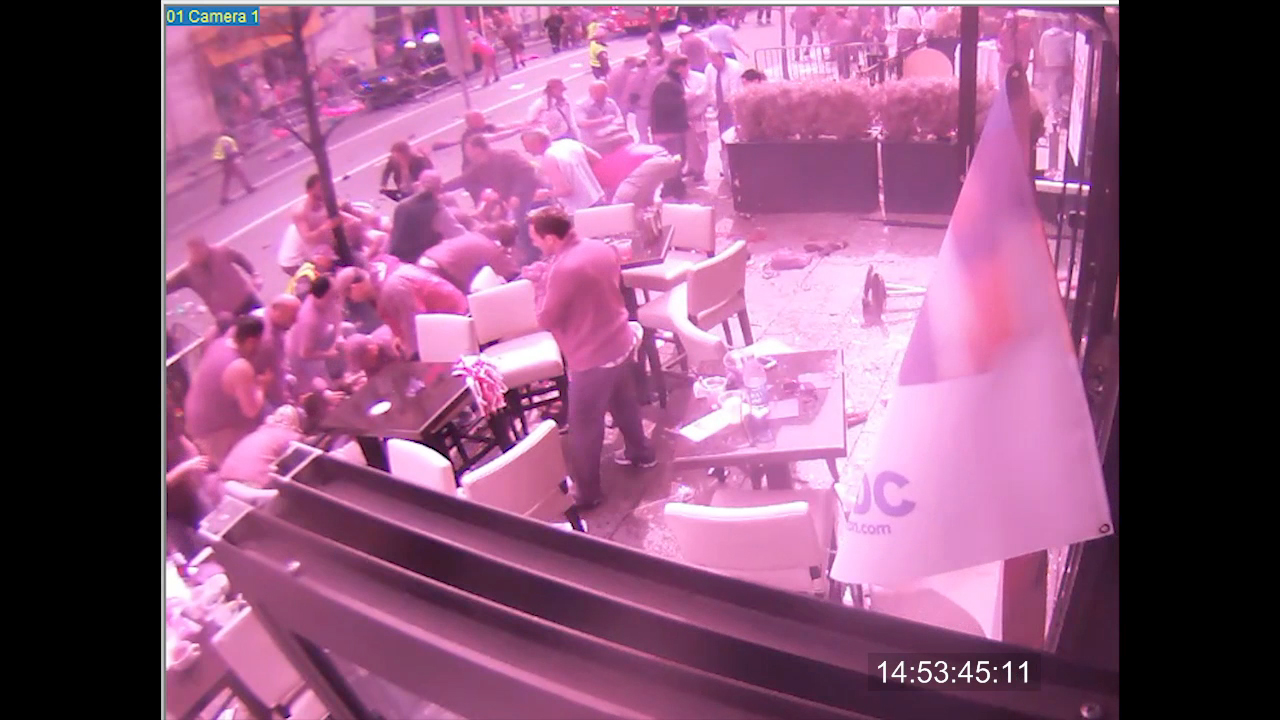Update 5/7/2015: CNN recently aired this forged photo in their documentary Murder at the Marathon:
Three days after the Marathon bombings, on April 18th 2013, the same day the Tsarnaevs were declared outlaws by the FBI, the Telegraph published a story based on some photos with Bill and Henry Richard at the second bomb site, father and brother of Martin Richard. The story has been taken offline soon, but a link to it - see above - shows one of the photos the article is about.
The picture belongs to a series of three photos obviously taken by the same photographer within a few seconds, because the perspective and the depicted persons are the same in large part. The two other photos were presumably also part of the Telegraph article and downloaded by someone before the article vanished. The order Photo A - Photo B - Photo C is chronological.
Photo A
Photo B
Photo C
This blog post is meant to make the case for the three photos being forged, because it is impossible that "Bill and Henry Richard" (whom I will refer to as Father and Son because I'm not certain about their identity) have been at this particular location - the area around the little road sign - at the same time as certain persons in the background. The background without Father and Son is consistent, it depicts conclusively and comprehensibly the scene at the road sign about 5 minutes after the blast. But Father and Son seem to have been digitally superimposed onto it afterwards.
My argumentation works like a time zoom. Using other established video and photographic material as reference, namely the Fred Land video, it is possible to narrow down the time slot for the creation of the photos in several steps. For the rest of the article, all time data designate minutes:seconds after the blast, with the "after the blast" omitted.
For start, the photos were not made before 3:20 because only at this point the barrier at the road sign was removed. At 5:06 Father and Son are seen hurrying away from the bomb site on the Fred Land video. This amounts to an initial time slot of 3:20-5:06.
There are several firefighters on the photos. In Step 1 I'll show that the first firefighters arrived at the area at about 4:30, narrowing down the time slot to 4:30-5:06.
Step 2 will demonstrate that, by tracking Father and Son on other footage and matching their moves, Photo C cannot have been shot later than 4:58, narrowing down the time slot to 4:30-4:58.
Step 3 will demonstrate that, by tracking particular individuals on other footage and matching their moves, Photo C cannot have been shot earlier than 5:04. This is obviously not within the time slot established in Step 2.
Bottom line: Step 2 and Step 3 lead to mutually exclusive results regarding the time when the photos were created, suggesting that they are manipulated.
Step 1
Here are some photos/video stills between 3:40 and 4:30. No firefighters are visible near the road sign, neither Father and Son. For reference, take a look at this timeline of Father and Son.
3:40
4:05
4:09
4:21
On the last photo some firefighters are already on their way toward the site. A little bit later, at 4:30-4:35, two of them have arrived at the road sign; one with a yellow vest with two crossing red stripes and a black strap over the back. I have highlighted him by a yellow rectangle. Another one is wearing a blue cap, highlighted by a blue rectangle.
4:30
4:35
Both firefighters appear in Photo A and/or Photo C:
It is therefore evident that Photos A, B, and C have been shot after 4:30.
Step 2
Father and Son traverse the Fred Land video's field of view between 5:06 and 5:15. Here's a screenshot at 6:08 in the video, corresponding to 5:08 after the blast.
The following diagram illustrates their path. The blue dots represent their location in 1-second intervals.
The diagram also sketches the field of view of Photo C. The sight lines of the photo's right and left border and the center line cut in one point, the position of the photographer. He was apparently standing in front of fire truck "Ladder 17".
Father and Son's speed in the Fred Land video can easily be determined as about 2 meters/sec. The distance of their position in Photo C to their entry point in the video is about 16 meters, which allows it to pinpoint the time of Photo C at 4:58 under the condition of a constant speed.
Whereas they may have moved more slowly before being visible in the video, it is highly unlikely that they were able to reach a higher speed while running arm in arm. It is therefore safe to say that Photo C may have been shot before 4:58, but certainly not later.
Step 3
Step 3 is a bit more tricky than the previous ones and will introduce two gentlemen depicted in the photos.
At 6:03 in the Fred Land video (5:03 after the blast) a runner enters the area from the right. He wears white shorts, a striking two-colored jacket and a cap. I name him "White Shorts". He is fairly fast, jumps over a barricade at 5:07 and leaves the field of view at 5:08. This snapshot from 5:06 highlights White Shorts by a white rectangle. Father and Son are just getting visible on the right.
The diagram illustrates White Short's path in the video:
White Shorts is also on this little known video. At the beginning, fire truck Ladder 15 is just moving ahead, enabling it to pinpoint the video's start at 4:41. Between 0:03 and 0:06 in the video (i.e. between 4:44 and 4:47 after the blast) White Shorts can be seen standing at the stop line near the forum. Then the camera sways away, so it cannot be exactly determined when he started to move.
And interestingly, he is also visible in Photo B:
This results in the following diagram.
In the Fred Land video, White Shorts' speed is about 4 meters/second. Given that he kept a constant speed before entering the video, Photo B depicts him 3 seconds earlier, at 5:00. Even if he was walking or running slower at the moment when Photo B was shot and accelerated on the last steps, he certainly didn't need more than five seconds from Photo B until entering the video.
This means Photo B was not shot before 4:58. But what is the time difference between Photo B and Photo C?
While the changes from Photo A to Photo B are so small that the difference is 1 second at most (note the firefighter in the foreground who just steps from the street onto the sidewalk), the changes from Photo B to Photo C suggest a bigger timely difference.
Another gentleman helps solving the problem. I name him "Red Jacket" because he wears a red "Red Sox" jacket. He is on all three photos, I have highlighted him by a red rectangle.
Red Jacket's location has distinctly changed between Photo B and Photo C. On Photo B (and Photo A) he is near the Forum entrance, at the borderline between the patio and the sidewalk. On Photo C, he is at the curb directly in front of the road sign.
Red Jacket could not move straightly from the patio to the curb because the path was blocked by injured people and first responders. The diagram illustrates the situation: To arrive at the curb, Red Jacket was forced to move carefully around the hatched area. For this maneuver he needed at least six seconds, most probably more.
This means that the time difference between Photo B and Photo C is at least 6 seconds. So if Photo B was not shot earlier than 4:58, Photo C was not shot earlier than 6:04. This is a contradiction to the findings in Step 2 und leads to the compelling conclusion that Photo C and, as a corollary, Photo B and Photo A are not genuine.
The reasoning in Step 2 and Step 3 sounds tricky and complicated, but it is essentially quite easy. It can be expressed very shortly in algebraic terms, if we take the greater or equal sign (≥) as "happened not earlier than" and the less or equal sign (≤) as "happened not later than".
Step 2:
Photo C ≤ 4:58 (Father and Son)
Step 3:
Photo B ≥ 4:58 (White Shorts)
Photo C ≥ Photo B + 0:06 (Red Jacket)
------------------------------------------------
Photo C ≥ 6:04
Contradiction - Q.E.D. The photos must be forged.





















